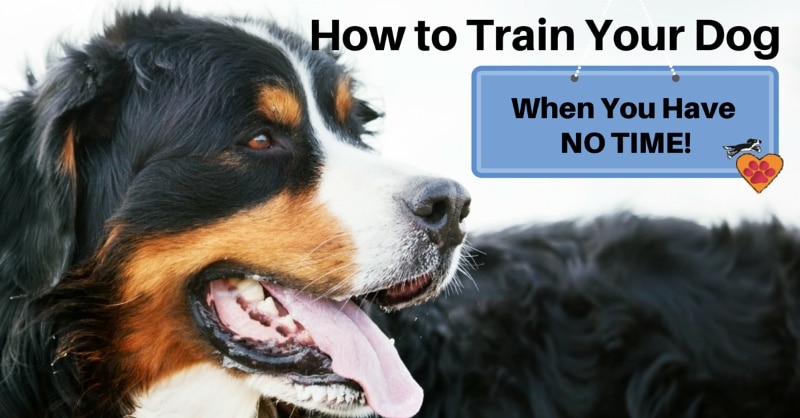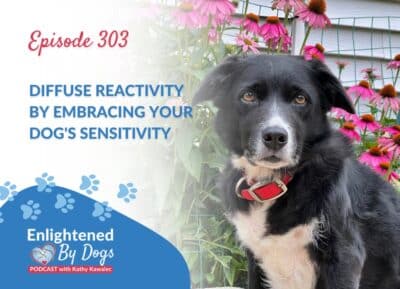A most common complaint from people about training their dogs.
You know, I’ve been working with horses and dogs for a really long time, about 35+ years I guess. And, for the past 25 years, I’ve been helping teach people how to have a better relationship with their dogs, and how to get results in a way that feels great to them AND their dogs.
Over the years, one of the most common ‘complaints’ I hear from folks is:
“I don’t have time to train my dogs.”
As a result, their dogs misbehave, don’t have good social skills, don’t respond to cues…you know, the really important stuff suffers.
Well, if you’re anything like me, and most dog people I know, life IS crazy busy.
It’s true: it seems like there is not enough time in the day to do everything we want to do.
And, often times, resolving those troublesome behaviors takes the back seat, because priorities rule.
Here’s another important thing I’ve discovered after years of struggling with the ‘no time’ problem:
We do NOT need to set up a ‘training session’ to train our dogs.
As a matter of fact, when it comes to basic life and relationship skills, it’s better NOT to have a ‘training session’.
Yep, you heard me right. After research and a discovery process to learn why my most admired dog trainers and handlers, and later my self, had success at this important foundation training, without training sessions, this was my conclusion. And, this is ONE of the key principles of dog training success.
Here’s how it works:
- Dogs naturally seek information and guidance from their people. (we are their “role models”)
- If relevant information is not received from us, dogs become worried, anxious or even frantic…this is often interpreted as unruly behavior, or ignoring behavior, or blamed on distractions.
- Being focused and attentive allows valuable dialog between a person and their dog. This is where the magic happens!
- Our own inattentiveness accidentally teaches our dogs to be inattentive to us and our requests. (Remember, we are role modeling how we want our dogs to behave)
- All throughout the day, every single day, each time you are with your dog: Be attentive and teach your dog important life skills as you live your life together.
What I’ve found is that we don’t need to ‘train’ our dogs until we move into specialty areas, like: herding, agility, rally, disc, obedience, conformation.
If we teach our dogs to be responsible members of the family as we interact in every day life, our dogs are automatically trained…AND future specialty training is crazy easy.
Action Steps
- Read my “5 Step Formula for Dog Training Success” book again, this time noticing how Mary incorporates Max’s training into everyday living and how effective it was for them.
- Each time you interact with your dog in any way, practice staying really focused on just your dog for a few seconds at a time.
- During those times of focus, add in some simple requests that teach your dog how to focus on you, how to be attentive to your body language, how to have impulse control by waiting for you to lead the action.
- Increase your mutual attentiveness by a few seconds each interaction, remembering to admire and praise your dog for being attentive.
- And remember to praise/reward yourself too!
In a week’s time, you’ll notice you and your dog are more attentive and responsive to one another … and that your dog is more willing to follow your lead and happily comply with your requests.
That will continue to get better over time, as you learn to become even more attentive and responsive to each other…creating a brilliant collaborative partnership!
Try it and let me know how it goes!






8 Responses
Good starting point,
Read and noted, thanks
Hi I have 4 dogs,2 retrievers and 2 herding dog x’s. On their own all 4 are fairly well trained and attentive. Trouble is most of the time they are all together this is when mayhem occurs! Mostly when I come home,they are all so happy to see me and my older (5) herder will be aggressive towards the other dogs. I have been told and believe he needs to learn impulse control. After his initial reactiveness he will go grab a toy and calm down but by then the younger (1) border/heeler mix is in a barking frenzy! I am working on getting the two of them to learn Place and go there when I come home but it is hard! He, Arlo, is also dog reactive in public so we tend to do our hiking where we won’t encounter other dogs,he has learned to watch me when we are leash walking/running and see other dogs but this is only when we are solo if I have one of the other dogs he goes into a complete frenzy! Any suggestions or insights would be great. In the meantime I will keep reading and watching! Thanks Keri
Oh my goodness! You put into words my problem exactly! I only have 2 dogs (Border Collie and a Cattledog mix), their behavior is what you describe…and I feel bad taking one out without the other…so we don’t go out much. I was having a hard time simplifying the description of their behavior. Thank you for your post.
Love this. Thank you. I’ve been guilty of the “I don’t have time” mentality. This makes much more sense.
Got a really close relationship with my 2yr old collie/lab x, and he’s gentle, friendly (but playful) with visiting people/children/dogs. But after a couple of incidents out walking (where dogs have lunged at him) he is now nervous(reactive) when we meet on the road. Must admit I’m nervous too which I know won’t help!
Will follow your guidelines and build a deeper connection, as I’d also like to achieve a 100%recall – currently about 70%!
awesome! Have you registered for the upcoming partnership workshop yet? That will give you more ideas too. 🙂
Thank you. I have a 13 month female Samoyed. She is a lovely dog and gets excited easily whether it’s someone knocking at the door or other dogs passing our home or the possum or birds in the backyard! We are struggling with her pulling on leash, no good recall, lunging or jumping on people or other dogs in her excitement. I tried the calm dog guide by another trainer who advocates humane guidance and showing leadership. However one of the requirements is in conflict with what you advised which is to give our dogs the attention when they seek. In this guide we are to ignore her when we come home until she settles or if she approaches and encroach into our space when we are sitting we need to gentle push her away until we invite her. So I am getting confused on what I should do if I come home and she looks at me .. do I ignore or go to her straight away.
Best regards
Well, there is a basic difference of philosophy, and taking one thing out of the context of the bigger picture (like the greeting) is not going to help. Have you been listening to my podcast? That should give you some greater insights on how to have a partnership with your pup, and how to give her the boundaries and guidance she needs … without pushing or dominating her. https://www.enlightenedbydogs.com